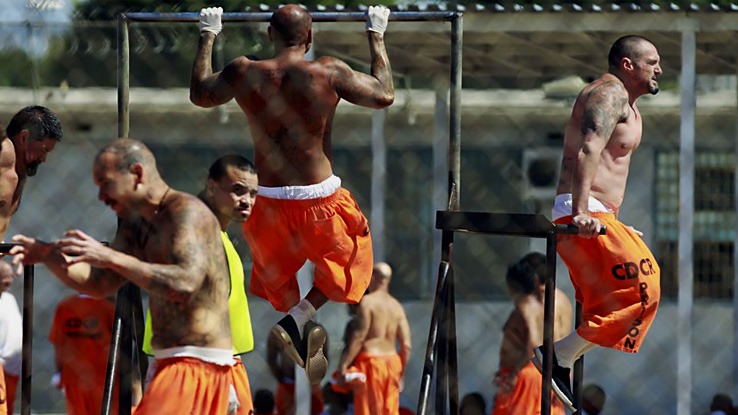
Prison-Style Fitness: Discipline and Routines Behind Bars.
Prison-style fitness emphasizes discipline, routine, and mental toughness, using minimal space and equipment to build strength, endurance, and resilience. Born behind bars, these workouts rely on bodyweight exercises and creativity, transforming confinement into opportunity. Beyond physical gains, they cultivate focus, self-control, and perseverance, offering lessons in fitness and life that extend far beyond prison walls.
💪 Fitness Guru
50 min read · 8, Oct 2025

Introduction: The Birth of Prison Fitness Culture
Behind the concrete walls and steel bars of prisons, where space is limited and equipment is scarce, a unique form of fitness was born—prison-style fitness. This training is not about aesthetics or vanity; it’s about survival, discipline, and regaining control in a place designed to strip away freedom. For inmates, staying fit was not optional—it was a psychological and physical necessity. Over time, these intense, no-equipment routines gained fame outside prison walls for their raw effectiveness and brutal simplicity.
In modern fitness circles, prison-style workouts symbolize mental resilience, resourcefulness, and self-mastery. They remind us that fitness isn’t about luxury gyms—it’s about dedication, routine, and pushing your limits with what you have.
The Philosophy Behind Prison Workouts: Discipline Over Equipment
The foundation of prison fitness lies in discipline and consistency. Inmates have structured schedules and limited distractions, which fosters an environment of routine. Fitness becomes a way to cope with stress, assert control, and maintain dignity in confinement.
The philosophy centers around three pillars:
- Self-Reliance: You are your own coach, motivator, and equipment.
- Consistency: Every day has structure—routine replaces chaos.
- Simplicity: Complex machines are replaced by bodyweight mastery.
This philosophy extends beyond prison walls—prison-style fitness is about mastering the basics until they become second nature, turning the body into its own gym.
Training Environment: Turning Constraints into Creativity
Prisons are not designed for physical fitness. Inmates must use limited space, no equipment, and strict time windows. Yet, this constraint has fueled creativity. Cell walls, bunks, and even towels become tools for muscle-building.
For example:
- A bunk bed doubles as a pull-up bar.
- A floor corner becomes a dip station.
- A cell wall becomes resistance for push-up variations.
- Towels are used for resistance curls or stretching.
These conditions created a minimalist, high-efficiency system—“train hard, train smart, train anywhere.”
Popular Prison Exercises: The Core of the Regimen
Prison workouts rely heavily on bodyweight exercises. These movements are compound, engaging multiple muscle groups and building both strength and endurance. Below are the most popular examples:
1. Push-Ups: The Prisoner’s Benchmark
Prisoners often perform hundreds of push-ups daily. Variations like diamond, wide-grip, and one-arm push-ups are used to target different muscles. Inmates develop remarkable upper-body endurance and discipline through repetition.
2. Squats: Lower-Body Power
Without weights, squats become the primary leg workout. “Prison squats” are often performed in high repetitions—sometimes up to 500 per day—building strength and cardiovascular stamina simultaneously.
3. Pull-Ups and Chin-Ups: Upper Body Sculpting
Pull-ups are a classic in any prison yard where a bar exists. These exercises develop back, biceps, and grip strength. Variations like towel pull-ups or close-grip chin-ups keep the challenge alive.
4. Dips: Chest and Triceps Dominance
Dips between bunks or sturdy surfaces work the triceps and chest deeply. These mimic parallel bar dips found in gyms but require creativity and balance.
5. Burpees: The Ultimate Prison Cardio
Burpees combine squats, push-ups, and jumps into a single explosive movement. They are a total-body workout and serve as the main endurance challenge for inmates.
6. Planks and Leg Raises: Core Stability
Core training is essential for overall strength. Planks, sit-ups, and leg raises are simple yet highly effective for building a rock-solid midsection.
7. Shadowboxing: Mental Focus and Cardio
Many prisoners add shadowboxing for conditioning and coordination. It enhances focus, reflexes, and cardiovascular endurance, while also serving as a mental release.
The Role of Routine: Structure in Chaos
In prison, structure is survival. Inmates build strict daily routines to create stability and purpose. Fitness becomes a ritual—a replacement for lost freedom.
A typical prison-style daily routine might look like this:
Time Activity 5:30 AM Wake up, meditation or reflection 6:00 AM Morning workout (push-ups, squats, abs) 8:00 AM Breakfast 9:00 AM - 12:00 PM Assigned prison duties or education 12:30 PM Lunch 1:00 PM Second workout (pull-ups, dips, cardio drills) 5:00 PM Evening reflection, journaling 6:00 PM Dinner 8:00 PM Relaxation, sleep prep This rigid structure promotes mental discipline and helps maintain a sense of control in a controlled environment.
Mental Benefits: Strength Beyond Muscles
Prison fitness is as much about the mind as the body. Exercise acts as a coping mechanism, helping inmates deal with isolation, frustration, and aggression.
Key psychological benefits include:
- Emotional Regulation: Intense workouts release endorphins, reducing anger and anxiety.
- Sense of Control: In an environment where freedom is lost, fitness provides ownership of one’s body and progress.
- Goal-Oriented Thinking: Progress in push-up counts or endurance fosters motivation and self-esteem.
- Resilience: Repetitive hard work conditions the mind to persist despite hardship.
These mental benefits have made prison-style fitness appealing to civilians seeking mental toughness and inner stability in chaotic modern life.
Transformation Stories: Redemption Through Fitness
Countless ex-inmates credit prison workouts with transforming their lives. For many, fitness became the gateway to self-respect and rehabilitation.
For example:
- Coss Marte, a former drug dealer, founded ConBody, a fitness program based on prison-style training that helps ex-convicts find employment and purpose.
- Calisthenics athletes around the world, including street workout enthusiasts, credit prison-style training for its simplicity and power.
These success stories show that fitness can be a tool of redemption, turning confinement into personal evolution.
Modern Adaptation: Prison Workouts Go Mainstream
Today, prison-style fitness has transcended its origins. It’s now a recognized training system in the fitness industry—praised for efficiency and accessibility. You’ll find “prison workouts” on YouTube, fitness apps, and even group classes in gyms.
Why it appeals to modern athletes:
- No equipment needed—perfect for home or travel workouts.
- High intensity, fast results—build strength and endurance quickly.
- Focus on mindset—develops grit and discipline.
- Functional fitness—improves real-world movement efficiency.
The minimalist philosophy aligns with modern fitness trends emphasizing bodyweight training, HIIT, and mental well-being.
A Sample 5-Day Prison-Style Workout Routine
Day Focus Key Exercises Reps/Sets Day 1 Upper Body Push-ups, dips, planks 5 rounds, 25 reps each Day 2 Lower Body Squats, lunges, calf raises 5 rounds, 30 reps each Day 3 Cardio Burpees, mountain climbers 4 rounds, 20 reps Day 4 Core Sit-ups, leg raises, flutter kicks 4 rounds, 25 reps Day 5 Full Body Pull-ups, burpees, squats 5 rounds, 15 reps This cycle can be repeated weekly, increasing repetitions as endurance improves.
The Discipline Factor: Mindset Over Motivation
In prison-style training, motivation is irrelevant—discipline rules. There are no cheering coaches, mirrors, or supplements—only raw willpower. The success of these workouts lies in consistency, not comfort.
As one ex-inmate famously said:
“You don’t need motivation when your life depends on routine.”
Prison-style fitness is a unique and intense form of training that has emerged from the confines of correctional facilities around the world, where limited space, minimal equipment, and strict schedules force inmates to rely on their own bodies and mental fortitude to maintain physical health, and it is not merely a way to build muscle or achieve aesthetic goals, but rather a multifaceted approach to survival, mental resilience, and structured living, because life behind bars is inherently restrictive, often monotonous, and psychologically taxing, and for inmates, physical fitness becomes a tool for coping with these challenges, a means of asserting control over their bodies and minds in an environment designed to strip away freedom and autonomy, and the philosophy underlying prison workouts emphasizes three primary principles: self-reliance, as the prisoner must become both the coach and the trainee, understanding the mechanics of each movement and pushing themselves beyond perceived limits; consistency, because repetition and daily commitment are what transform not just the body but also the mental capacity to endure hardship and discomfort; and simplicity, because complex machines and equipment are typically unavailable, requiring exercises that leverage one’s own weight, available surfaces, or improvised tools like bunks, bars, or towels to provide resistance and variation, and this minimalist approach fosters creativity, problem-solving, and adaptability, as inmates must often convert their cells into functional gyms, using a bedframe for pull-ups, a floor corner for dips, or a towel for resistance curls, and the workouts themselves tend to focus on compound, functional movements that maximize efficiency, such as push-ups in their numerous variations, which strengthen the chest, shoulders, and triceps while also challenging endurance, or squats and lunges, which engage the lower body and core, sometimes performed in extremely high repetitions to build stamina in the absence of weights, pull-ups and chin-ups, which develop back, arm, and grip strength, dips that target triceps and chest, burpees that combine cardio and full-body strength into one explosive movement, and core exercises like planks, sit-ups, and leg raises, which ensure that the trunk remains strong to support overall physical performance, and these exercises are often sequenced in rigorous routines that occupy multiple hours per day, sometimes broken into morning, midday, and evening sessions to maintain structure, with the structured schedule itself being as important as the exercises, because routine helps instill discipline, regulate emotions, and provide a sense of purpose in an environment where chaos and idleness can be mentally destructive, and beyond the physical benefits, prison workouts offer profound psychological advantages, as consistent exercise releases endorphins, reduces stress, and mitigates aggression while fostering a sense of control, self-esteem, and achievement, particularly crucial in a setting where external autonomy is severely restricted, and this mental aspect is why prison-style fitness resonates with civilians as well, particularly those seeking not only physical strength but also mental toughness, resilience, and self-mastery, and the principles behind these workouts have been exported into mainstream fitness, with programs like ConBody, founded by ex-inmate Coss Marte, demonstrating that the same routines that kept prisoners disciplined and healthy can also transform the lives of civilians and former convicts alike, building strength, confidence, and a purpose-driven mindset, and this wider adoption has cemented prison-style training as a respected method within calisthenics and functional fitness communities, because its efficiency, minimalistic approach, and emphasis on perseverance align perfectly with modern fitness trends that prioritize mental toughness, resourcefulness, and results without reliance on expensive equipment, and moreover, the routines themselves are highly scalable, allowing beginners to start with manageable repetitions while more advanced practitioners can push their limits through higher counts, variations, or added difficulty, and the beauty of this system is that it not only improves muscular endurance, cardiovascular capacity, flexibility, and coordination but also reinforces life skills such as patience, delayed gratification, and the ability to embrace discomfort, all of which translate well beyond the gym or prison walls, fostering holistic development of body and mind, and it is this combination of practicality, discipline, and mental fortitude that makes prison-style fitness compelling to people seeking to cultivate resilience in every area of life, because the ultimate lesson of these routines is that transformation is possible in any environment if one harnesses consistency, creativity, and sheer willpower, proving that limitations in space, equipment, or circumstance do not define potential, and that with the right mindset, one can achieve remarkable physical and psychological growth, making prison-style fitness not just a training methodology but a philosophy of life that emphasizes endurance, adaptability, and self-mastery, encapsulating the notion that the greatest strength is forged not in comfort or luxury, but in adversity, repetition, and relentless commitment, and in the modern world, where distractions are plentiful and instant gratification often undermines long-term goals, adopting the principles of prison workouts—structured routines, bodyweight mastery, and mental discipline—can help anyone cultivate not only a strong, functional physique but also an unbreakable mindset, reminding us that true fitness extends beyond the body to encompass the determination, resilience, and self-control necessary to face life’s challenges with confidence and strength.
Prison-style fitness is a unique, intense, and highly disciplined approach to physical training that has emerged from the harsh, restrictive environments of correctional facilities around the world, where inmates are forced to rely solely on their bodies, creativity, and mental toughness to maintain health, strength, and endurance, and it is much more than just a workout—it is a philosophy of self-reliance, consistency, and mental fortitude, because in a place where freedom is stripped away, where resources are scarce, and where daily life is regimented and monotonous, the body becomes one of the few tools for asserting control and maintaining identity, and fitness in prison is not about vanity or aesthetics but about survival, emotional regulation, and empowerment, providing inmates with a structured outlet for stress, frustration, and aggression, while also offering a sense of achievement and personal pride in an environment where choice is extremely limited, and the foundational principles of this type of training are built on simplicity and efficiency, utilizing minimal or no equipment, such as bodyweight exercises, improvised resistance using bunks, bars, or towels, and creative use of cell space, turning limitations into opportunities to push the body to its maximum potential, and exercises like push-ups in countless variations, including diamond, wide-arm, and one-arm push-ups, serve not only to strengthen the chest, shoulders, and triceps but also to enhance muscular endurance and mental toughness, while squats, lunges, and wall sits work the lower body and core, often performed in extraordinarily high repetitions to build stamina and leg strength without the need for weights, and pull-ups and chin-ups, whether performed on bars or using makeshift alternatives, target the back, arms, and grip strength, developing a functional upper body that is capable of enduring prolonged physical activity, while dips between beds or sturdy surfaces enhance the chest and triceps further, burpees combine full-body strength with cardiovascular conditioning, planks, sit-ups, and leg raises strengthen the core, and shadowboxing or improvised martial arts movements improve coordination, reflexes, and mental focus, creating a holistic approach that builds not just muscles but also endurance, agility, and resilience, and the routines are deeply embedded in a strict daily schedule that emphasizes routine and repetition, which is crucial for mental stability and discipline in a confined environment, because in prisons, structure replaces freedom and chaos, and the daily regimen often involves multiple workouts spread throughout the day, alternating between strength, cardio, and core exercises, ensuring that physical activity becomes a consistent ritual, with the psychological benefits being just as significant as the physical ones, including improved mood, stress relief, emotional regulation, self-confidence, and a sense of control over one’s body and mind, which is particularly important in an environment designed to diminish personal autonomy and self-esteem, and beyond the walls of prisons, this training methodology has inspired modern fitness programs worldwide, with calisthenics enthusiasts, athletes, and even ex-inmates turning prison-style workouts into organized fitness routines, emphasizing that high-repetition, bodyweight-based training can yield remarkable results in strength, endurance, and physique, and programs like ConBody, founded by Coss Marte, exemplify how prison workouts can be adapted for the general population, providing both physical conditioning and empowerment, while also offering rehabilitative opportunities for formerly incarcerated individuals, and the adaptability of prison workouts is one of their strongest appeals, as exercises can be scaled according to fitness levels, time availability, or environment, making them accessible to anyone regardless of equipment, location, or financial resources, and the broader lesson of prison-style fitness lies in its emphasis on discipline over motivation, demonstrating that long-term commitment, consistency, and mental resilience are more important than short bursts of enthusiasm, because true transformation—both physical and mental—comes from daily effort, perseverance, and the ability to embrace discomfort, challenges, and limitations, and this mindset, cultivated behind bars out of necessity, translates perfectly to modern life outside of prison, where distractions, convenience, and instant gratification often undermine self-control and productivity, and by adopting the principles of prison-style fitness, individuals can cultivate a structured, purposeful approach to training that enhances functional strength, endurance, and overall well-being, while simultaneously reinforcing character, patience, resilience, and focus, ultimately proving that the human body and mind are capable of remarkable adaptation when pushed consistently and intelligently, and in essence, prison-style fitness is a testament to the power of routine, creativity, and mental fortitude, showing that even under extreme limitations, anyone can achieve significant physical, psychological, and emotional growth, and that the core of this approach is not just the repetition of exercises but the cultivation of a mindset that values discipline, perseverance, and self-mastery above all else, which is why this training methodology has inspired countless civilians, athletes, and fitness enthusiasts to embrace the simplicity, intensity, and transformative power of working out anywhere, with minimal resources, proving that strength, resilience, and personal development are not dependent on luxury gyms, equipment, or external validation, but rather on the consistent application of effort, determination, and the mental toughness that prison-style workouts demand, making it one of the most practical, effective, and life-changing approaches to fitness available today.
Conclusion
Prison-style fitness is more than a physical regimen—it’s a philosophy of self-discipline, resilience, and transformation. It demonstrates that the human body and mind can thrive even under extreme constraint. With nothing but bodyweight and determination, inmates have built physiques and mental strength rivaling professional athletes.
In today’s world, where convenience often replaces effort, prison-style fitness reminds us of a timeless truth: discipline beats comfort. You don’t need a gym to get stronger—you need commitment. This system teaches not just how to train, but how to live—focused, consistent, and in control.
Q&A Section
Q1: What is prison-style fitness?
Ans: Prison-style fitness is a bodyweight-based training system developed by inmates, emphasizing discipline, routine, and mental toughness. It uses minimal or no equipment to build strength, endurance, and resilience.
Q2: Why do prisoners focus so much on fitness?
Ans: Inmates exercise to stay healthy, reduce stress, and maintain control in a restrictive environment. Fitness also serves as an emotional outlet and a way to build self-esteem and purpose.
Q3: What are the most common prison exercises?
Ans: Push-ups, squats, burpees, pull-ups, dips, sit-ups, and planks are the core of prison workouts, as they require no equipment and engage multiple muscle groups.
Q4: Can I do prison-style workouts at home?
Ans: Yes. The beauty of this training method is that it can be done anywhere. All you need is your bodyweight and commitment to consistent practice.
Q5: Is prison-style fitness effective for building muscle?
Ans: Absolutely. High-repetition bodyweight exercises build functional strength, muscular endurance, and a lean, defined physique. With proper nutrition, it can rival traditional gym training.
Similar Articles
Find more relatable content in similar Articles

Prison-Style Fitness: Discipline and Routines Behind Bars...
Prison-style fitness emphasize.. Read More

Fitness as Therapy for Anger, Stress, and Sadness...
Fitness is not just about buil.. Read More

Body Care Habits You Should Never Skip — For Both Him and H..
Body care isn’t just about lo.. Read More

Ice Workouts: Training in Extreme Cold for Fat-Burning...
“Discover the chilling science.. Read More
© 2024 Copyrights by rFitness. All Rights Reserved.